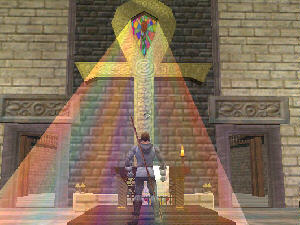Sunday 26 August 2001

|
Pic of the day: From the Cathedral of Love. Screenshot from Ultima IX, Ascension. G.U.T. of magic, part 2On Freeday, I mentioned my Grand Unified Theory of magic: That all use of magic requires an exchange of order for chaos. Life and magic both straddle the border between Chaos and Order: Life leaning more toward order, magic more toward chaos; but both of them have an arm and a leg in the other realm. The heart of the magic feat, then, is Sacrifice. In a wider sense than commonly used, it is an exchange of life/order for magic/chaos. I will now show how this perspective can be applied to some very different instances: AD&D spells, Margit Sandemo's good-luck charms, and mainstream christian mass or service. ***In AD&D roleplaying, spells have to be memorized. This is a separate action that must be performed prior to casting. Now if this was like memorizing a complex formula or a text in an unfamiliar language, you would be able to use it again and again. At the very least, it would take much less time for each memorize, until you eventually knew it by heart. But spells are literally "cast": Once used, they are unknown again and must be memorized from scratch. From this I conclude that the internal representation of the spell is sacrificed ... that is, it is exchanged for a corresponding quantity of rule-bending chaos. The final proof of this is the use of spell scrolls to cast a spell without memorizing. In this case, the physical scroll is destroyed in the exchange. This proves that an orderly construct of some sort is sacrificed for magic: Either internally in the mage's mind, or externally in the form of a scroll. An interesting side effect of this is that an untrained mageborn person might figure out how to invoke magic by sacrificing part of his soul, such as a memory or an emotion. At first this might look like a good idea; but the sacrificed part never comes back! Like the spell scroll, it is gone forever. Eventually the untrained mageborn will turn insane, a hollow shell. ***Scandinavian and middle European readers may be familiar with the unique magics of Margit Sandemo. Among the main sources of magic in her later books are the Holy Sun of the Kingdom of Light, and the Norse Galder. Both of these have given rise to pieces if jewelry in the form of orderly patterns worked in silver and gold and worn as an amulet for good luck and wishing power. (The amulets can in Norway be ordered from Bladkompaniet. You may need to buy one of the corresponding books first, which would anyway be a good idea since people may stop you on the street and ask questions.) The way such an amulet would work is by functioning as a very simple spellbook. While looking at it, you capture an image of moderately complex order. If you have a slight talent for magic, this packet of order may be traded off as you make a wish or feel a need, and in its place you get a very small piece of rule-bending chaos. Something possible, but not quite likely, happens instead of the more likely outcome. -For such an exchange to have effect, the pattern should not be too simple. The highest power comes when you combine order and complexity. Fractal patterns seems a good choice. NB: There is no guarantee that this will work outside of fantasy books... ***In contrast, the rituals of traditional christian churches have been used for centuries in the real world. You may doubt the effect, but that is your problem. I mention this only as an example of how my theory of magic can be applied even a bit into the realm of religion. In this case, we happen to know that the Roman Catholic Church at least considers sacraments valid even if the ritual is performed by a person whose heart is not right before God. (It is also very hard to check hearts, even at the best of times.) In the Mass and other classical church services, both a priest and the congregation take some part in the rituals. This may include singing specific songs, performing specific movements, or praying pre-defined prayers. The intention is typically an exchange between God and the congregation: The congregation gives praise to God, and God blesses them in one way or another. This could be very subtle and spiritual, or rather practical, or both of the above. Miraculous healings are not unheard of, though most people these days probably don't expect much when they go to church. If you watch a traditional church service with which you are not familiar, you may notice that it virtually screams MAGIC. The priest moves in predefined patterns while citing ritual texts. The congregation supplies more gymnastics and ritual chants. According to my theory then, these orderly activities are made into a sacrifice, in order to obtain back a piece of chaos: A break in the laws of nature. Food for thought indeed. I have deleted several paragraphs of more detailed comment, to protect my readers who may be believers. Even so, I recommend that you use these thoughts only for roleplaying and fiction, so as to not needlessly imperil your soul. I have seen what thinking can do to believers, and it is not pretty. |
Gray day, but no rain. |
Yesterday <-- This month --> Tomorrow?
One year ago
Two years ago